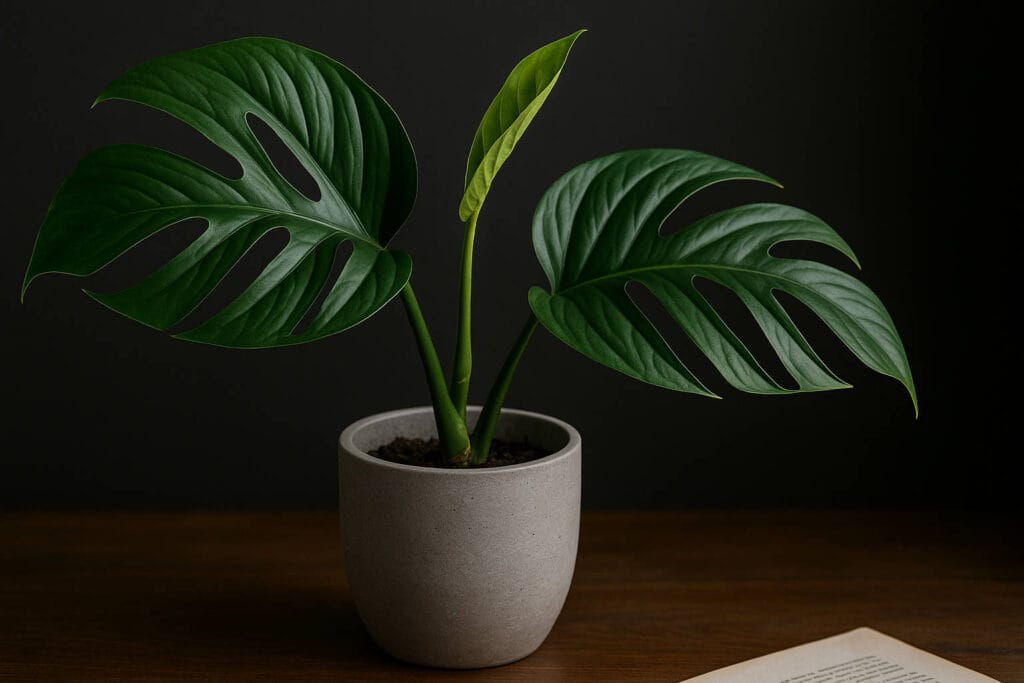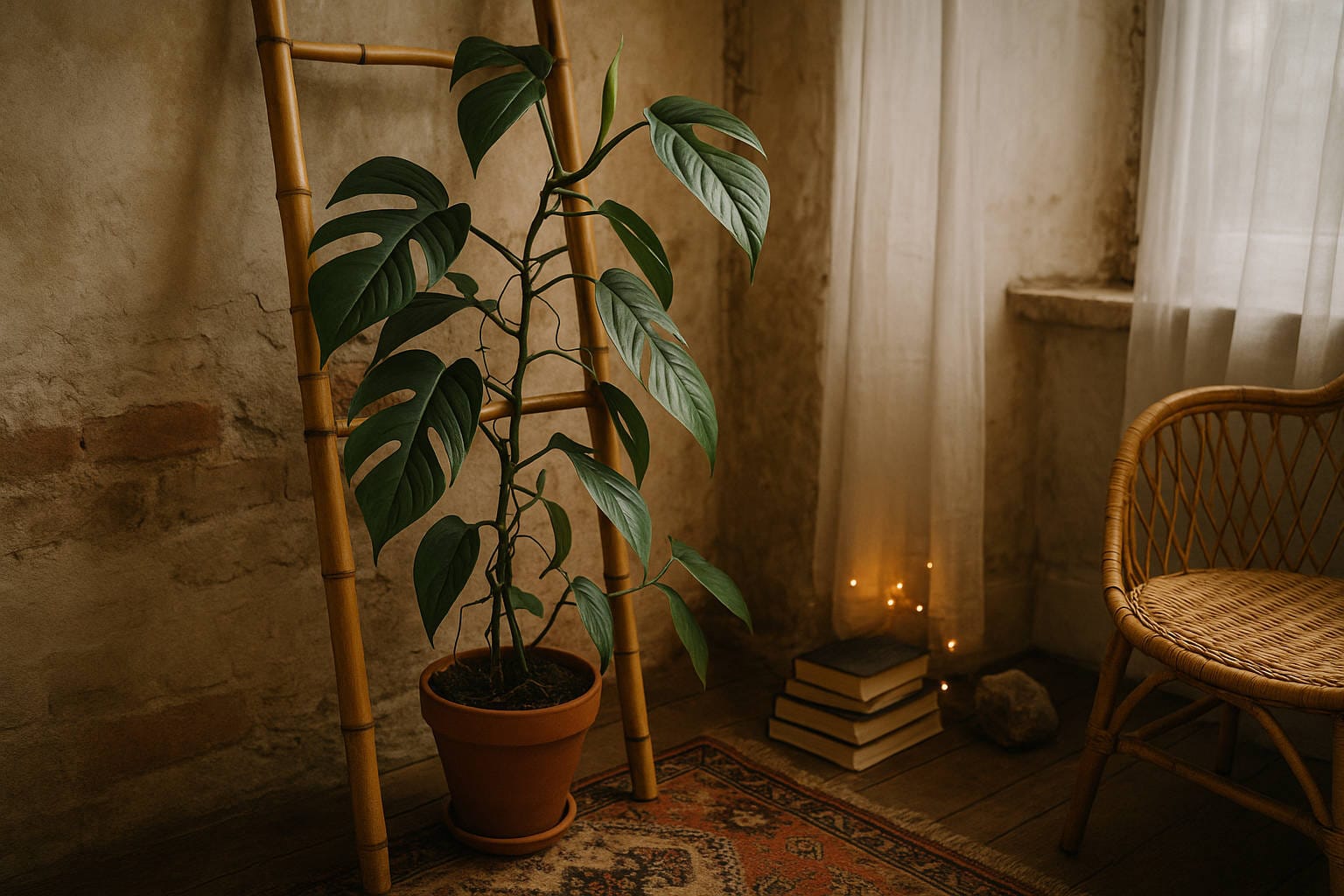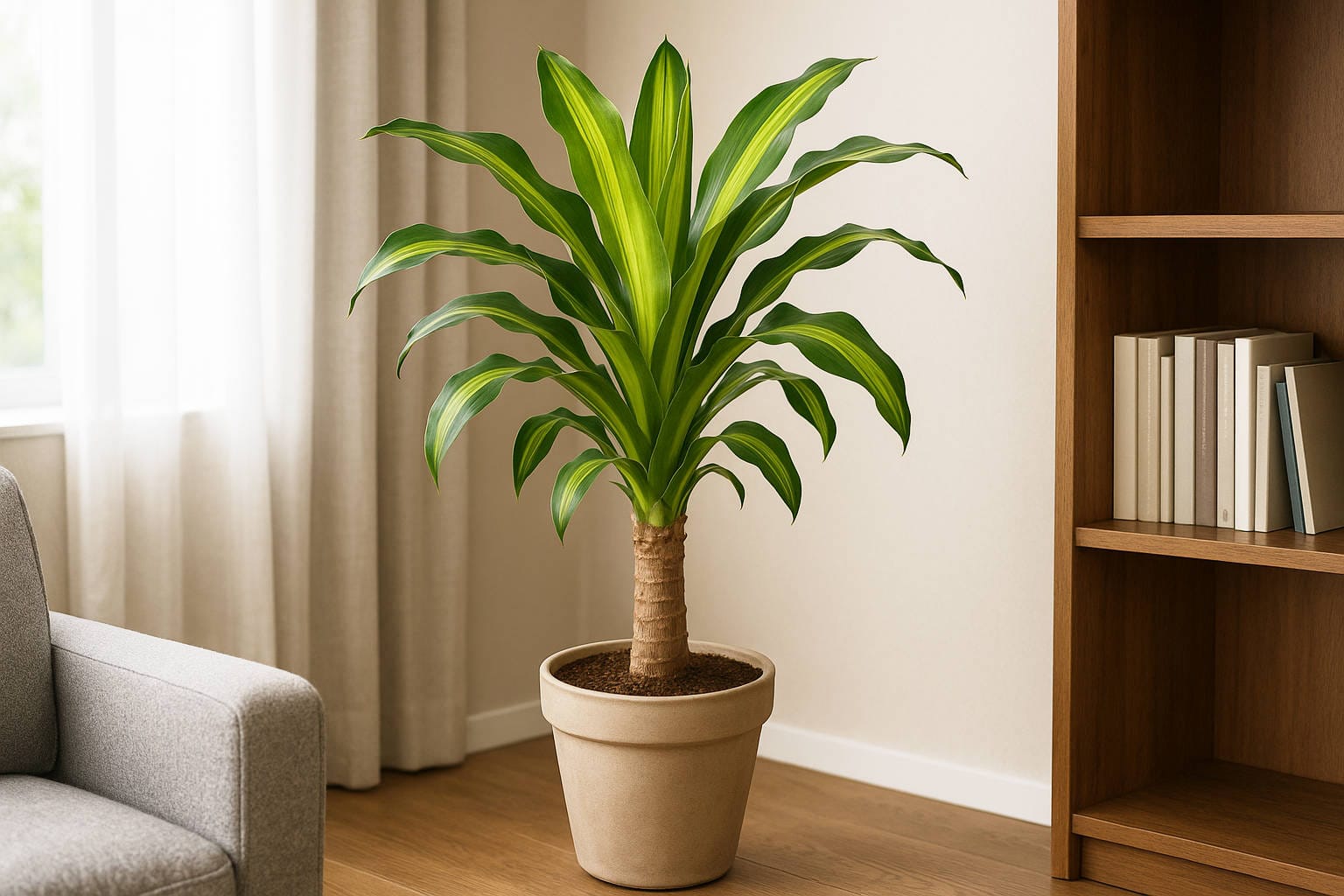You’ve heard about the dragon tail plant, maybe saw one in a friend’s living room or scrolling through PlantTok, and now you’re wondering: What’s the deal with this plant that looks like a pothos but grows like a beast? You’re not alone.
The dragon tail plant (botanically known as Epipremnum pinnatum) is making a name for itself in the indoor gardening world — and for good reason. It’s easy to care for, adapts well to indoor spaces, and its leaves change shape as it grows.
In this guide, we’ll walk you through everything you need to know about growing and taking care of this tropical climbing plant. We’ll go over where it comes from, what it needs to stay healthy, how to plant and repot it, when and how to water it (without killing it), how to deal with pruning and pests, and even a few bonus tips to make it look its best.
By the end, you’ll have what you need to keep your dragon tail plant not just alive, but thriving — even if you’re new to this whole plant thing.
Ready to dig in?
What Is the Dragon Tail Plant?
Alright, let’s clear things up. The dragon tail plant is the common name for Epipremnum pinnatum, a tropical vine that’s part of the Araceae family — same as pothos, Monstera, and Philodendron. So, if it reminds you of those, you’re not imagining things.
This plant originally comes from Southeast Asia and parts of the Pacific, but it’s become a popular houseplant all over — especially in the U.S., Australia, and Europe.
It’s loved for its glossy green leaves, which start out simple and smooth but get big and fenestrated (those cool splits and holes) as the plant matures and climbs. The older it gets, the wilder it looks.
Now here’s something important: because it shares a genus with pothos (Epipremnum aureum), people sometimes mix them up. But unlike pothos, the dragon tail plant develops much more dramatic leaf shapes over time, especially if you give it a support like a moss pole or trellis. It can grow long — really long — and it looks amazing when trained to climb.
Indoors, it works great in hanging baskets, wall-mounted planters, or as a climbing accent in a corner. Outdoors (in warm regions like southern Florida or Hawaii), it can get a little out of control, so it’s best to grow it in containers unless you want a jungle vibe.
If you’re into low-maintenance indoor plants that still feel a little exotic and interesting, the dragon tail might just be your new favorite.
You may also like:
- Tomato Plant Leaves Turning Yellow? 7 Causes and Easy Fixes
- Planter Pool Landscaping: 5 Gorgeous Designs + Maintenance Guide
Ideal Growing Conditions for the Dragon Tail Plant
If you want your dragon tail plant to grow strong and show off those funky leaf splits, you’ve gotta give it the right environment.
Don’t worry — it’s pretty chill as houseplants go. But like any living thing, it has its preferences.
Light
Let’s start with light. This plant loves bright, indirect sunlight — think near a window with filtered light or behind sheer curtains. It can handle lower light too, but it won’t grow as fast, and the leaves may stay small. Direct sun? Nah — that’ll scorch the leaves.
If your space is on the darker side, try putting it near an east- or north-facing window. Got only west- or south-facing ones? You can still make it work — just diffuse the light with a sheer curtain.
Temperature
Being tropical, the dragon tail likes it warm — somewhere between 65°F and 85°F. Keep it away from cold drafts and AC vents. If you’re comfy in a T-shirt, your plant probably is too.
Humidity
Here’s where things can get a bit picky. The plant loves humidity, but it won’t throw a fit if the air’s a bit dry. That said, if your leaves start looking crispy at the edges, bump up the humidity. You can group it with other plants, place a tray of water nearby, or run a small humidifier.
Soil
Now for the dirt. Use a well-draining potting mix — something light and airy. A mix made for aroids (or one you DIY with potting soil + perlite + orchid bark) works perfectly. Just don’t let it sit soggy.
Get these four things right — light, warmth, humidity, and soil — and your dragon tail will be climbing in no time.
You may also like:
- 7 Plants That Attract Dragonflies and Keep Mosquitoes Away Naturally
- Brazilian Wood Plant Care: How to Grow It in Soil or Water Indoors
How to Plant a Dragon Tail Plant
Got your dragon tail plant and ready to give it a proper home? Awesome. Let’s walk through how to plant it the right way so it thrives.
Choosing the Right Pot
First things first: pick a pot with drainage holes. This is non-negotiable. No matter how careful you are with watering, a pot that holds water like a soup bowl will lead to root rot.
Size-wise, go for a pot that’s just a bit larger than the root ball. Too big and the soil will stay wet too long; too small and the roots won’t have room to spread.
Picking the Soil
We talked about this earlier, but it’s worth repeating: use a well-draining mix. If you’re buying one, look for something labeled for aroids or tropical houseplants. If you’re mixing your own, combine:
- 2 parts potting soil
- 1 part perlite
- 1 part orchid bark or coco chips
This keeps things airy and prevents water from pooling around the roots.
Planting Steps
- Prep your pot: Add some soil to the bottom — enough so the plant will sit at the same depth it was in its nursery pot.
- Remove the plant: Gently take it out of its current pot. Loosen the roots if they’re tightly wound.
- Place and fill: Set the plant in the pot and fill in around it with soil. Press lightly to secure it but don’t pack it down hard.
- Water: Give it a solid drink. Let water run out of the drainage holes — then you’re done.
Optional but Recommended: Add Support
If you want those signature fenestrated leaves, give your dragon tail a moss pole or trellis to climb. You can stick it in right after planting and gently tie the vine to it with soft plant ties.
You may also like:
How and When to Water a Dragon Tail Plant
Watering houseplants sounds simple, right? But it’s where most people go wrong — either drowning them with love or forgetting about them entirely. The dragon tail plant is forgiving, but it does better with a bit of consistency.
So, How Often Should You Water It?
Short answer: when the top inch or two of soil is dry. For most indoor environments, that means about once a week. But don’t set a calendar reminder and call it good — always check the soil first.
Stick your finger into the soil up to your first knuckle. If it feels dry, go ahead and water. If it’s still damp, wait a couple of days.
In warmer months or if your home is dry, you might need to water more often. During winter, it’ll slow down — once every 10–14 days might be enough.
Watering the Right Way
When you water, do it thoroughly. Let water run out the bottom of the pot, and then dump out any water sitting in the saucer. Don’t let the roots sit in standing water. That’s the fast track to root rot.
If your plant’s in a decorative pot without a drainage hole (you rebel), at least keep it in a nursery pot inside it — that way you can lift it out to water properly.
Signs You’re Doing It Wrong
- Yellow leaves? Might be too much water.
- Droopy leaves? Could be too little.
- Mushy stems or stinky soil? Probably root rot. Time to adjust your routine.
The dragon tail plant is pretty chill about water once you get the rhythm down. Keep it simple: check the soil, water deep, and avoid soggy feet.
You may also like:
How to Prune and Train Your Dragon Tail Plant
Now that your dragon tail plant is growing strong, it might start getting a little… wild. That’s actually a good thing — it means it’s happy.
But if you want to keep it looking neat (or encourage bigger, healthier growth), a little pruning and training goes a long way.
Why Prune It?
Pruning isn’t just about looks. It helps:
- Keep the plant compact and bushy
- Remove dead or damaged leaves
- Encourage new growth from the base
- Control size if it’s taking over your space
Basically, if your plant’s getting leggy, or you’ve got yellowing or sad-looking leaves, it’s time for a quick trim.
How to Prune
You’ll need clean, sharp scissors or pruning shears. Dirty tools = a one-way ticket to infection.
- Identify the stem you want to cut (right above a node — that’s where a leaf and root join the stem).
- Snip at an angle.
- That’s it. You’re done.
Don’t throw away the cuttings — you can use them for propagation (we’ll get to that later).
How to Train It
Want those dramatic, mature leaves with splits and holes? You’ll need to train your dragon tail to climb. It’s a natural climber, so all it needs is a little help:
- Add a moss pole, stake, or trellis into the pot
- Gently tie the stems to the support using soft plant ties, twine, or even twist ties (just not too tight)
- Keep the pole slightly moist if it’s moss — it encourages aerial roots to grab on
As it climbs, the plant matures and the leaves get more impressive. So don’t let it sprawl on the floor unless that’s the look you’re going for.
You may also like:
How to Repot or Transplant a Dragon Tail Plant


A dragon tail plant (Epipremnum pinnatum)
Eventually, your dragon tail plant is gonna outgrow its pot. When that happens, it’s time to give it more space — and maybe some fresh soil while you’re at it. Repotting sounds intense, but it’s really not a big deal once you’ve done it once or twice.
When Should You Repot?
Look out for these signs:
- Roots growing out the bottom of the pot
- Slowed growth even though you’re doing everything right
- Water runs straight through the soil like it’s not being absorbed
- The plant feels top-heavy or looks crowded
Generally, once every 1–2 years is a good rhythm, ideally in spring or early summer, when the plant’s in active growth mode.
Step-by-Step: How to Repot
- Pick a new pot: Go just one size up — too big, and the soil stays wet too long.
- Prep the soil: Same mix as before — well-draining and chunky. (Potting soil + perlite + bark is gold.)
- Remove the plant: Tip the pot gently and slide the plant out. If it’s rootbound, tease the roots apart a bit.
- Check the roots: Trim off anything that looks brown, mushy, or dead.
- Replant: Place the plant in the new pot, fill around with soil, and press lightly to anchor it.
- Water well: A good soak helps settle the soil and ease the shock.
Post-Repot Care
Keep the plant in a spot with indirect light and don’t fertilize for a few weeks — let it settle in. You might see a bit of drooping or slow growth at first, but that’s normal. It’ll bounce back.
Transplanting doesn’t just give your dragon tail more space — it refreshes the soil and gives the roots room to breathe.
That’s it — your dragon tail is planted and ready to settle in.
You may also like:
Common Issues and How to Fix Them
Even though the dragon tail plant is pretty low-maintenance, it’s still a living thing — and sometimes, things go sideways. The good news? Most issues are easy to fix once you know what to look for.
Yellow Leaves
The most common complaint. If you see yellowing leaves, think overwatering. Too much water can cause root rot, especially if your pot doesn’t drain well. Let the soil dry out before watering again, and check that your pot isn’t holding extra moisture.
Brown Tips or Edges
Usually a sign of low humidity or inconsistent watering. If the air in your home is dry (especially in winter), mist the plant occasionally, group it with other plants, or use a humidifier.
Droopy Leaves
Could be underwatering, overwatering, or transplant shock. Check the soil. If it’s bone dry — water it. If it’s soggy — stop watering for a few days and let it dry out. Repotted recently? Give it some time to bounce back.
Pests
Look out for:
- Mealybugs: White, cottony clumps on stems
- Spider mites: Fine webbing and tiny moving dots
- Scale: Brown or tan bumps that stick to the plant
Wipe leaves with a damp cloth or spray with diluted neem oil or insecticidal soap. Repeat weekly until they’re gone.
Leaf Drop
If your dragon tail is shedding a few older leaves, don’t panic — it’s normal. But if it’s dropping a bunch at once, something’s up. Check the light, water, and soil.
You may also like:
Bonus Tips for a Thriving Dragon Tail Plant
You’ve got the basics down — nice work. Now let’s level up. These extra tips will help your dragon tail plant not just stay alive, but really show off.
Propagation? Super Easy
One of the best things about this plant: it’s ridiculously easy to propagate. Just take a cutting with at least one node (that’s where a leaf and root bump meet), stick it in water or moist soil, and wait.
- In water, roots usually pop out in 1–2 weeks.
- In soil, keep it slightly moist and warm.
Once the roots are a couple of inches long, pot it up. Boom — new plant.
Rotate the Pot
This plant leans toward the light, so give it a quarter turn every week or so. That helps it grow evenly and keeps it from getting lopsided.
Clean the Leaves
Dust can build up and block light from getting in. Every few weeks, wipe the leaves with a damp cloth or rinse them gently in the shower. Cleaner leaves = better photosynthesis = happier plant.
Support = Bigger, Cooler Leaves
We’ve said it before, but seriously — if you want those mature, split leaves, give your plant something to climb. A moss pole, coir pole, or trellis will help it develop those signature dramatic vibes.
Don’t Overthink It
Yeah, plants can be needy, but the dragon tail isn’t one of them. If you’re doing the basics — light, water, soil — it’ll forgive a little neglect here and there.
Want it to grow like crazy? Treat it like it lives in the tropics: warmth, humidity, and something to climb.
You may also like:
Conclusion
So, what’s the deal with the dragon tail plant? It’s a seriously cool, low-fuss houseplant that brings tropical vibes to any room. As long as you give it bright, indirect light, well-draining soil, and water it when the topsoil’s dry — you’re golden. Throw in a moss pole or trellis and you’ll be rewarded with dramatic, split leaves that keep getting better over time.
Looking for another plant that’s low-effort but still delivers? Don’t miss our ultimate guide to spider plants — another houseplant favorite for beginners and pros alike.
FAQ – Dragon Tail Plant Care
1. Is the dragon tail plant toxic to pets?
Yes. Like many aroids, it’s toxic to cats and dogs if ingested. It can cause irritation, drooling, or vomiting — so keep it out of reach if you’ve got curious pets.
2. How big does a dragon tail plant get indoors?
With the right conditions and support, it can grow several feet long — easily 6 to 8 feet or more. It’s a natural climber, so it’ll keep going if you let it.
3. Can I grow a dragon tail plant outside?
Yes, if you live in a warm climate — USDA zones 10–11. In cooler areas, grow it in a pot and bring it indoors when temperatures drop below 60°F.
4. Why are the leaves turning yellow?
Usually a sign of overwatering or poor drainage. Check the soil, the pot, and your watering schedule.
5. How do I make the leaves split like in the pictures?
Give it time, support, and light. Mature leaves develop splits when the plant climbs and gets enough light and humidity.
6. Can I propagate the dragon tail plant in water?
Absolutely. Take a cutting with a node, place it in water, and wait for roots to form. Once they’re a couple inches long, you can plant it in soil.
7. How often should I repot it?
About every 1–2 years, or when it gets rootbound. Spring is the best time to repot.




